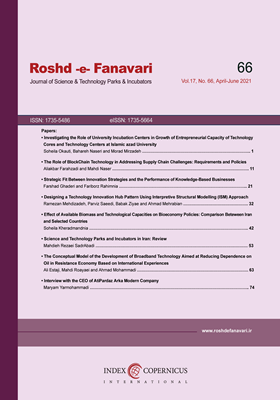The Conceptual Model of the Development of Broadband Technology Aimed at Reducing Dependence on Oil in Resistance Economy Based on International Experiences
Subject Areas : Technology Development Infrastructures and Supporting organizations
ali estaji
1
,
mahdi roayaei
2
![]() ,
Ahmad mohammadi
3
,
Ahmad mohammadi
3
1 - University of Tehran
2 -
3 -
Abstract :
Today, the importance of communication and especially the use of cyberspace, is so high that it is considered as one of the development strategies. In fact, Broadband Technology as a platform for Internet services is among the knowledge-based economy. according to the features such as the development of entrepreneurship and productivity growth, Broadband Technology has the ability to decrease the government reliance on oil revenues. The impact of technology on social and economic development of communities is undeniable, and based on the view of some experts, this technology is an important component in development of current economies. Broadband through the creation of market, new jobs, and infrastructure, and also by changing the economic system, will help economic and social development. Therefore, considering the position of broadband technology and the necessity to use it in the country in order to achieve the goals of the 20-year perspective, the institutionalization of the development and production of science and research, the increase of the share of gross national product in scientific production, the development and strengthening of the software movement, in this article the native development model Broadband technology is provided. To achieve this, two fundamental points are strict: First, take advantage of the experience of the leading countries in Broadband Technology. Second, considering the appropriateness native of our country. Considering these two principles, the national broadband development model has been clarified and the necessary requirements and measures to achieve those, expressed under the following topics: Prepare of supply and demand sides and the necessity of providing broadband infrastructure by government.
1- آرینمهر، شهرام؛ یحییآبادی، ابوالفضل؛ هرتمنی، امیر، بررسی تأثیر خصوصیسازی بر رشد اقتصادی در کشورهای عضو گروه D-8 با استفاده از مدل پانل پویای برآورد شده به روش GMM، فصلنامه پژوهشهای رشد و توسعه اقتصادی، سال 4، شماره 13، صص 11-28، تابستان 1392.
2- درگاهی، حسین؛ علیپور فلاحپسند؛ محمدحسن؛ حیدری قرهبلاغ، هادی، ارائه مدل شایستگی در توسعه منابع انسانی، فصلنامه راهبرد یاس، شماره 23، پاییز 1389، صص 91-113.
3- اصغرزاده، عبداله؛ محمدی، روحاله، روند قیمتگذاری در صنعت سیمان و برآورد نقش تولیدکنندگان در قیمتگذاری این کالا، دوماهنامه بررسیهای بازرگانی، شماره 13، صص ۶۲-۶۷، مرداد و شهریور 1384.
4- قلمبر دزفولی، علیرضا، 15 برابر شدن سرعت انتقال داده در نسل جدید اینترنت، . 9 12. Accessed 8 19، 1394. http://www.irapp.ir/shownews.php?id=3227.
5- کارخانهای، ابراهیم، خروج ارز با افزایش ضریب نفوذ اینترنت با استفاده از پهنای باند سایر کشورها،.6 22. http://rc.majlis.ir/fa/news/print_version/902868.
6- مهدیزاده، مهران، تحلیل شاخصهای رقابت جهانی و بررسی این شاخصها در کشورهای خاورمیانه، فصلنامه راهبرد یاس، شماره 27، پاییز 1390، صص 125-153.
7- مهربانی، وحید، مقرراتگذاری در بازار کار و تأثیر آن بر بهرهوری؛ شواهدی از صنایع ایران، فصلنامه پژوهشهای اقتصادی ایران، شماره 45، زمستان 1389، صص 199-220.
8- نصیری، بهاره و عقیلی، سید وحید، بررسی آموزش سواد رسانهای در کشورهای کانادا و ژاپن، فصلنامه نوآوریهای آموزشی، شماره 41، بهار 1391، صص ۱۳۷-۱۶۲.
9- یداللهزاده طبری، ناصرعلی؛ نصرالهی، محمد؛ بزرگتبار سرحمامی، محمدابراهیم، تأثیر پهنای باند اینترنتی بر رشد اقتصادی کشورهای عضو اوپک نفتی، کنفرانس ملی تحلیل راهبردی دیدگاههای مقام معظم رهبری در اقتصاد و مدیریت، بابل: دانشگاه آزاد اسلامی بابل، 1393.
10- OECD, Broadband growth and policies in OECD countries, Paris: OECD, 2008.
11- Horrigan, John, home broadband adoption, Project, Washington, DC: PEW, 2009.
12- Fornefeld, Martin, Gilles Delaunay, and Dieter Elixmann, The Impact of Broadband on Growth and Productivity, MICUS Management Consulting GmbH for EC, 2008.
13- Kim, Yongsoo, Tim Kelly, and Siddhartha Raja, Building broadband: Strategies and policies for the developing world, Washigton D.C.: The world bank, 2010.
14- Sirbu, Marvin A., Sharon E. Gillett, William H. Lehr, and Carlos A. Osorio, Measuring Broad band’s Economic Impact, Final Report _ National Technical Assistance, Training, Research, and Evaluation Project, U.S Department of Commerce, Washington, DC: Economic Development Administration, 2006.
15- Sharma, Ashish , Karim Sabbagh, and Jai Sinha, Bringing Mass Broadband to India, Roles for Government and Industry, New Delhi: Booz & Company, 2014.
16- Kelly, Tim, and Carlo Maria Rossotto, Broadband Strategies Handbook, Washington D.C.: World bank, 2012.
17- Jungmihn , Jamie Ahn, "Broadband Policy in South Korea: the effect of government Regulation on Internet Proliferation," Pacific Telecommunications Council 12, Honolulu: Pacific Telecommunications Council, 2012, pp. 1-16.
18- Koutroumpis, Pantelis, The Economic Impact of Broadband on Growth:A simultaneous approach, Telecommunications Policy, No. 33, 2009, pp. 471-485.
19- Crandall, Robert W,; Singer, Hal J, The Economic Impact of Broadband Investment, Washington, DC: National Cable & Telecommunication Association, 2007.
20- Falch, Morten, "Penetration of broadband services – The role of policies," Telematics and Informatics, No, 24, 2007, pp. 246-258.
21- Cook, Mark and Healey, Nige, Supply Side Policies, Forth, London: Heineman educational publishers, 2001.
22- Frieden, R., Best Practices in Broadband: Lessons from Canada, Japan, Korea and the United States, Pennsylvania: University Park, 2004.
23- Ministry of Transport and Communications, Finnish Telecome Policy, Helsinki: Miktor, 2010.
24- Ferguson, C. H, The U.S. broadband problem, brookings, http://www.brookings.edu/comm/policybriefs/pb105.htm, 2002.
25- Kurihara, Kazuya, A Comparative Study of Industrial Policies and Broadband Deployment in the Telecommunications Industry: the case of the U.S., Japan, and Germany, A Thesis for the degree of Master of Arts, Washington, D.C.: Communication Cultre and Technology, 2007.
26- BIS, Britain’s Superfast Broadband Future, London: Department for Business innovation and skills, 2010.
27- Johnston, R., Technology Planning in Major Asian Countries: An Analysis of Recent Foresight Reports from China and India & Comparison with Japan and Korea, PMSEIC Working Group on Asia, 2006.
28- Federal Communications Commission, Connecting America: The National Broadband Plan, Federal communications commission, 2010.
29- Lee, Choongok, and Sylvia M. Chan-Olmsted, "Competitive Advantage of Broadband Internet: A Comparative Study Between South Korea and the United States," Telecommunications Policy No. 28 , 2007, pp. 649–677.


